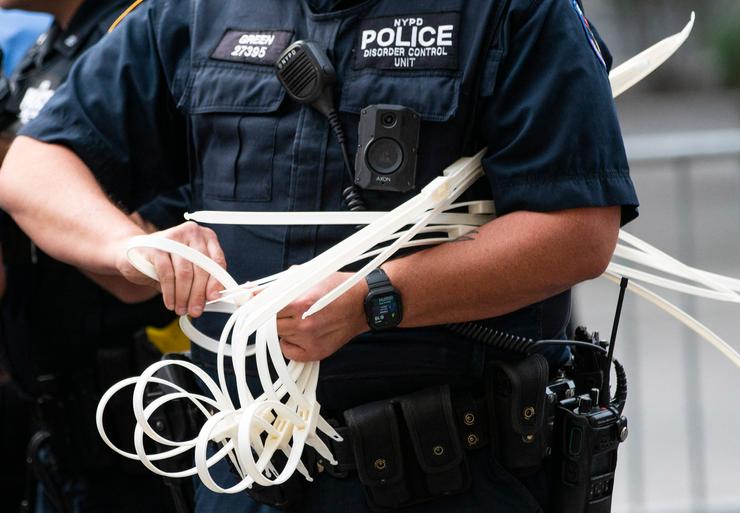Whether police admit it or not, their profession is on fire. They are increasingly tasked with jobs that fall outside their area of competence, from domestic violence response to crisis de-escalation to mental health first aid. And more police spending hasn’t paid the dividend of reduced crime.
Police officers in the U.S. have also proved to be dramatically more lethal than those in any other nation, killing more than a thousand civilians last year. Police violence echoes other deeply American forms of inequity against Black and brown people. The additional harm done through racial profiling, stop-and-frisk, racialized community surveillance and criminalizing children is difficult to quantify and exists at a near-universal scale. Still, detractors of reform on the right and left are threatening Americans with escalating unrest if we dare to modernize our philosophy on public safety.
Their emotional appeals and skewed data points are working, with mainstream media parroting lies that efforts to defund the police unleashed the wave of crime we’re seeing reported across the country. In reality, we didn’t defund the police, and any uptick in crime is more likely the result of intersecting unprecedented phenomena, including our nation’s mental health crisis, a crumbling democracy, deepening political polarization, nationwide school disruptions, rampant homelessness and wealth inequality. Yet, falsehoods about reform are continually bandied about by political opportunists as the singular reason for people’s unchecked malfeasance.
In New York, where everyone lives in a constant state of pandemic-fueled whiplash, fearmongers are perfidiously warning people that Alvin Bragg, Manhattan’s new district attorney, will marshal the city into an era of crime and chaos given his pledge to seek jail or prison time for only the most serious crimes, unless the law requires otherwise. As D.A. Bragg has detailed repeatedly in laying out his evidence-based policies, the data doesn’t support these litanies of fear, yet this catastrophist perspective persists.
The good news is that, even in this time of tremendous uncertainty and division, there are still a few areas in which we can find consensus. Wherever you come from or whatever your background, we all want safety, opportunity, economic mobility, liberty, joy and prosperity in our communities. After more than a decade of working in American criminal law, I know public defenders can help make this vision our reality.
My career has spanned two states and more than 2,000 clients. I’ve worked inside the Los Angeles County Public Defender Office, the Santa Clara County Public Defender Office in California and the Bronx Defenders in New York City. I’ve tried criminal cases, resolved family and civil matters, and won release for people sentenced to life in prison. My experience has been varied, but helping systematically disenfranchised populations has always been central. To that end, I can say confidently that public defenders occupy a uniquely powerful position in our legal system.
“The time between arrest and the end of the court case is valuable time when clients could be getting better,” explains Tracie Olsen, chief public defender in Yolo County, California. “Public defenders are perfectly situated to assist clients during this time, but only if we’re funded properly.”
Situated early in the legal process, public defenders have immediate, confidential access to the people most at risk of both causing harm and being harmed. They are automatically assigned, thereby eliminating barriers to entry that might separate a person in crisis from available services. And, unlike any other public safety resource, they have the power to create tailored solutions for their clients, using restorative means rather than imprisonment. Since jails actually make future crime more likely and cause immeasurable harm to those detained within them, this method of restoring opportunity rather than destroying potential seems both rational and effective.
“When clients are arrested, they often need help with more than just their legal needs. They need help obtaining medications, finding shelter, locating a mental health counselor, entering treatment for addiction issues, or with transportation to get to court,” Olsen says. “When clients’ needs are met, they stop committing crime and stay out of jail. It’s just that simple.”
Thanks to my tenure with the Bronx Defenders, a legendary organization that supports a client’s entire personhood — their job, housing, family, health and unique human value — I was always able to work beyond the penal code as an attorney. The Defenders’ commitment to holistic defense showed me that a good lawyer prevents incarceration but a great lawyer gives people the tools to never be ensnared by that system again.
My experience reflects the research. A recent rigorous evaluation by the Harvard Law Review found that holistic defense reduces the likelihood of a jail or prison sentence by 16% and expected sentence length by 24%. Over the 10-year study period, holistic defense in the Bronx resulted in nearly 1.1 million fewer days of punishment in a cage.
Collaborative forms of defense are a simple solution that should be a public policy no-brainer. But it can be difficult to implement for jurisdictions unaccustomed to mixing services inside defense agencies.
In an effort to ensure that every person in America can one day access the kind of wraparound defender we know saves money and creates better outcomes, I left trial work to start Partners for Justice, a program to help every defender transform into a collaborative service hub.
By embedding specially trained advocates inside existing public defenders offices, we close the revolving door between arrest and incarceration, eliminating the need to pay for more than 150 years in jail, with upwards of 30,000 jail days cut from January to August 2021 alone.
“When I got out, me and my mom were basically on our own trying to figure out how to do Social Security, food stamps, etc.,” says Jason M., a client of Partners for Justice advocate Eliana Swerdlow. “[Eliana got] anything that I needed, really. Health insurance, medication, even getting clothes and whatnot, steering me through all the paperwork that would’ve took me months. [Eliana] had it done in a day.” Partners for Justice has connected thousands of people to social services and achieved about 80% of our service goals, like getting people access to health care, benefits or employment. “And it’s such a difference to where all these things aren’t weighing on me no more,” Jason adds. “It’s a fresh start. And then you got this team of people behind you, so you don’t want to let them down either.”
I mention Jason M. to demonstrate how much our local governments could save if they chose to resource public defenders while they engage in the longer conversation about the transformation of other public safety agencies. In some communities, a single public defender has had to handle upward of 19,000 misdemeanor cases annually. Crushing caseloads means defenders are unable to provide non-legal aid, as Eliana did for Jason ― a lost opportunity to build trust and ensure the client walks the right path.
When asked about how it feels to get services through parole, Jason describes that lack of trust: “You’re just hoping [the parole officer] doesn’t throw you in jail, you know? But when you’re dealing with somebody who’s not in a power position above you but instead is coaxing you along and helping you,” he says of Eliana, “it takes your mind and puts it in a positive area rather than being in your negative, everything’s-against-me, I don’t know what’s going on, I’m lost. It takes it and switches it to where now I’m on an even playing field, and I feel confident because I trust this person.”
On a macro level, our model at Partners for Justice makes economic and public safety sense. It can save taxpayer dollars through reduced use of jails and provides people with the tools and opportunities needed to thrive. It’s a public policy unicorn: a path to ending mass incarceration with no negative impact on public safety.
On a micro level, every one of those thousands of people we serve is a human life whose course has been, we hope, transformed by our help in accessing the tools they needed to succeed: A woman who resorted to stealing because of an ongoing crisis involving housing and her husband’s need for mental health care. A man about to lose his housing because he couldn’t read an eviction notice. A young man whose mental health crisis might have resulted in jail time had a public defense advocate not intervened to create better options. Or Jason, who shared, “Normally when I get out, I’m completely lost.... It’s an uphill climb just to get to normal.... When you have something like this to fall back on, it’s an unbelievable resource.... I’ve never experienced nothing like this. Coming out of jail, you’re on your own, you know?”
When every case is a human story, making investments in public defense is so much more than just a sensible budget choice.
As we seek a better, safer and more prosperous future, investing in those who are most ready to make tangible, transformative change now — our public defenders — is a good choice for all of us, regardless of our ideology.

